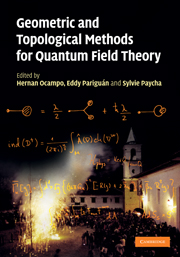Book contents
- Frontmatter
- Contents
- List of contributors
- Introduction
- 1 The impact of QFT on low-dimensional topology
- 2 Differential equations aspects of quantum cohomology
- 3 Index theory and groupoids
- 4 Renormalization Hopf algebras and combinatorial groups
- 5 BRS invariance for massive boson fields
- 6 Large-N field theories and geometry
- 7 Functional renormalization group equations, asymptotic safety, and quantum Einstein gravity
- 8 When is a differentiable manifold the boundary of an orbifold?
- 9 Canonical group quantization, rotation generators, and quantum indistinguishability
- 10 Conserved currents in Kähler manifolds
- 11 A symmetrized canonical determinant on odd-class pseudodifferential operators
- 12 Some remarks about cosymplectic metrics on maximal flag manifolds
- 13 Heisenberg modules over real multiplication noncommutative tori and related algebraic structures
8 - When is a differentiable manifold the boundary of an orbifold?
Published online by Cambridge University Press: 07 September 2010
- Frontmatter
- Contents
- List of contributors
- Introduction
- 1 The impact of QFT on low-dimensional topology
- 2 Differential equations aspects of quantum cohomology
- 3 Index theory and groupoids
- 4 Renormalization Hopf algebras and combinatorial groups
- 5 BRS invariance for massive boson fields
- 6 Large-N field theories and geometry
- 7 Functional renormalization group equations, asymptotic safety, and quantum Einstein gravity
- 8 When is a differentiable manifold the boundary of an orbifold?
- 9 Canonical group quantization, rotation generators, and quantum indistinguishability
- 10 Conserved currents in Kähler manifolds
- 11 A symmetrized canonical determinant on odd-class pseudodifferential operators
- 12 Some remarks about cosymplectic metrics on maximal flag manifolds
- 13 Heisenberg modules over real multiplication noncommutative tori and related algebraic structures
Summary
Abstract
The aim of this short chapter is to review some classical results on cobordism of manifolds and discuss recent extensions of this theory to orbifolds. In particular, I present an answer to the question “When is a differentiable manifold the boundary of an orbifold?” in the oriented case and in the unoriented case when we restrict to isotropy groups of odd order.
Introduction
When is a differentiable manifold the boundary of another differentiable manifold? This question was answered by Thom [14] in the 1950s; the necessary and sufficient condition is the vanishing of certain characteristic numbers, invariants defined by evaluating characteristic classes of the tangent bundle on the fundamental class of the manifold. His proof is one of the cornerstones of algebraic topology [2] and shows the powerful tools that homotopy theory gives to the study of the geometry of manifolds.
Orbifolds, originally introduced as V-manifolds by Satake [12], and so named by Thurston [15], are useful generalizations of manifolds: locally they look like the quotient of Euclidean space by the action of a finite group. Their study lies at the intersection of many different areas of mathematics, and they appear naturally in many situations such as moduli problems, noncommutative geometry and foliation theory. The local character of the definition of orbifolds allows many constructions that can be applied to manifolds to be extended to orbifolds, and it is natural to ask, When is an orbifold the boundary of another orbifold? Key ingredients of Thom's proof do not seem to extend naturally to orbifolds, and the interplay between geometry and homotopy theory, in this case, is still not understood.
- Type
- Chapter
- Information
- Geometric and Topological Methods for Quantum Field Theory , pp. 330 - 343Publisher: Cambridge University PressPrint publication year: 2010
- 1
- Cited by



